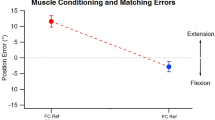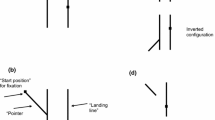Summary
Some aspects of the manner in which the central nervous system uses sensory information for the guidance of eye and arm movements were investigated. When subjects experience apparent motion of their restrained forearm, induced by vibration of their biceps muscle in the dark, they are able to pursue with their eyes at least part of this “motion” and to point with their nonvibrated limb to the apparent location of the vibrated arm. The presence of a small target light on the vibrated hand limits the extent of illusory change in limb position and results in illusory motion of the target light in the same direction as the arm motion. When asked to indicate the spatial position of the light or hand, subjects still point with their nonvibrated arm to the apparent locations. Although visual pursuit of the illusory motion of the forearm can still be elicited in the presence of the target light on the hand, the subjects' eyes remain steadily fixating the stationary target light when they are instructed to track its illusory motion. These findings demonstrate that sensory and motor factors affecting the perception of visual direction and the guidance of arm and eye movements can be differentially employed at several levels of central nervous control.
Similar content being viewed by others
References
Bowditch, H.P., Southard, W.F.: A comparison of sight and touch. J. Physiol. (Lond.) 3, 232–245 (1880)
Brandt, T.H., Büchele, W., Arnold, F.: Orthokinetic nystagmus and egomotion sensation. Exp. Brain Res. 30, 331–338 (1977)
Goodwin, G.M., McCloskey, D.I., Matthews, P.B.C.: Proprioceptive illusions induced by muscle vibration: Contribution to perception by muscle spindles? Science 175, 1382–1384 (1972a)
Goodwin, G.M., McCloskey, D.I., Mathews, P.B.C.: The contribution of muscle afferents to kinaesthesia shown by vibration-induced illusions of movement and by paralysing joint afferents. Brain 95, 705–748 (1972b)
Hanson, R.M., Skavenski, A.A.: Accuracy of eye position information for motor control. Vision Res. 17, 919–926 (1977)
Helmholtz, H. von: Treatise on physiological optics. New York: Dover 1962
Lackner, J.R.: Proprioceptive facilitation of open loop visual pointing. Percept. Motor Skills 39, 263–265 (1974)
Lackner, J.R.: Pursuit eye movements elicited by muscle afferent information. Neurosci. Lett. 1, 25–28 (1975)
Lackner, J.R.: Some mechanisms underlying sensory and postural stability in man. In: Handbook of sensory physiology, Held, R., Leibowitz, H.W., Teuber, H.-L. (eds.), Vol. VIII, pp. 805–845. Berlin, Heidelberg, New York: Springer 1978
Lackner, J.R., Evanoff, J.: Smooth pursuit eye movements elicited by somatosensory stimulation. Neurosci. Lett. 4, 43–48 (1977)
Lackner, J.R., Levine, M.S.: Visual direction depends upon the operation of spatial constancy mechanisms: the oculobrachial illusion. Neurosci. Lett. 7, 207–212 (1978)
Lackner, J. R., Levine, M. S.: Changes in apparent body orientation and sensory localization induced by vibration of postural muscles: vibratory myesthetic illusions. Aviat. Space Environ. Med. (in press)
Lackner, J.R., Zabkar, J.J.: Proprioceptive information about target location suppresses autokinesis. Vision Res. 17, 1225–1229 (1977)
Mach, E.: Contribution to the Analysis of the Sensations (Transl. C.M. Williams). Chicago: Open Court Publishing 1897
Steinbach, M.J.: Pursuing the perceptual rather than the retinal stimulus. Vision Res. 46, 1371–1376 (1976)
Woodworth, R.S.: The accuracy of voluntary movement. Psychol. Rev. Monogr. Suppl. 3, 1–114 (1899)
Yasui, S., Young, L.R.: Eye movements during afterimage tracking under sinusoidal and random vestibular stimulation. In: Eye movements and psychological processes (ed. R.A. Monty and J.W. Senders). New Jersey: Lawrence Erlbaum Association 1976
Author information
Authors and Affiliations
Rights and permissions
About this article
Cite this article
Levine, M.S., Lackner, J.R. Some sensory and motor factors influencing the control and appreciation of eye and limb position. Exp Brain Res 36, 275–283 (1979). https://doi.org/10.1007/BF00238911
Received:
Issue Date:
DOI: https://doi.org/10.1007/BF00238911




